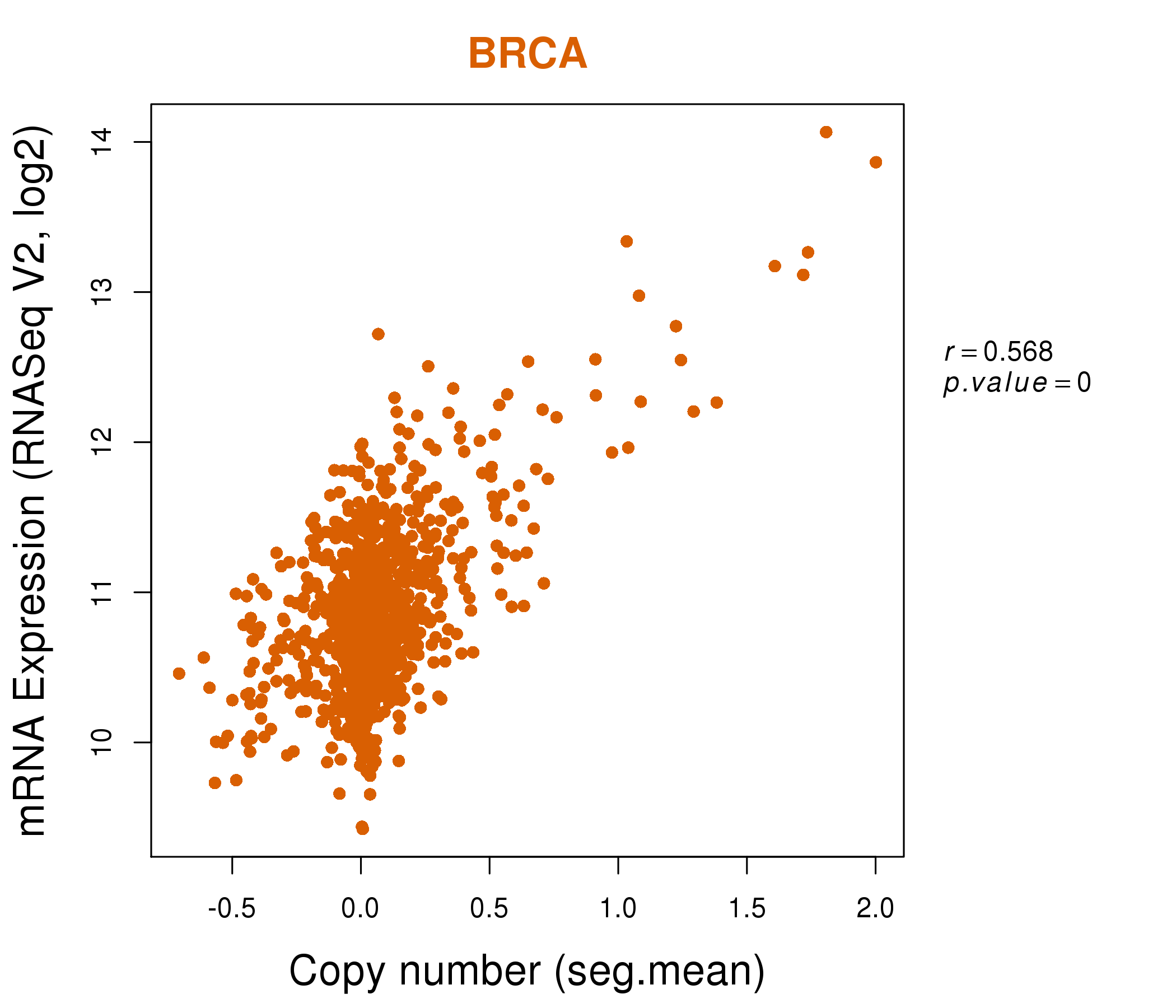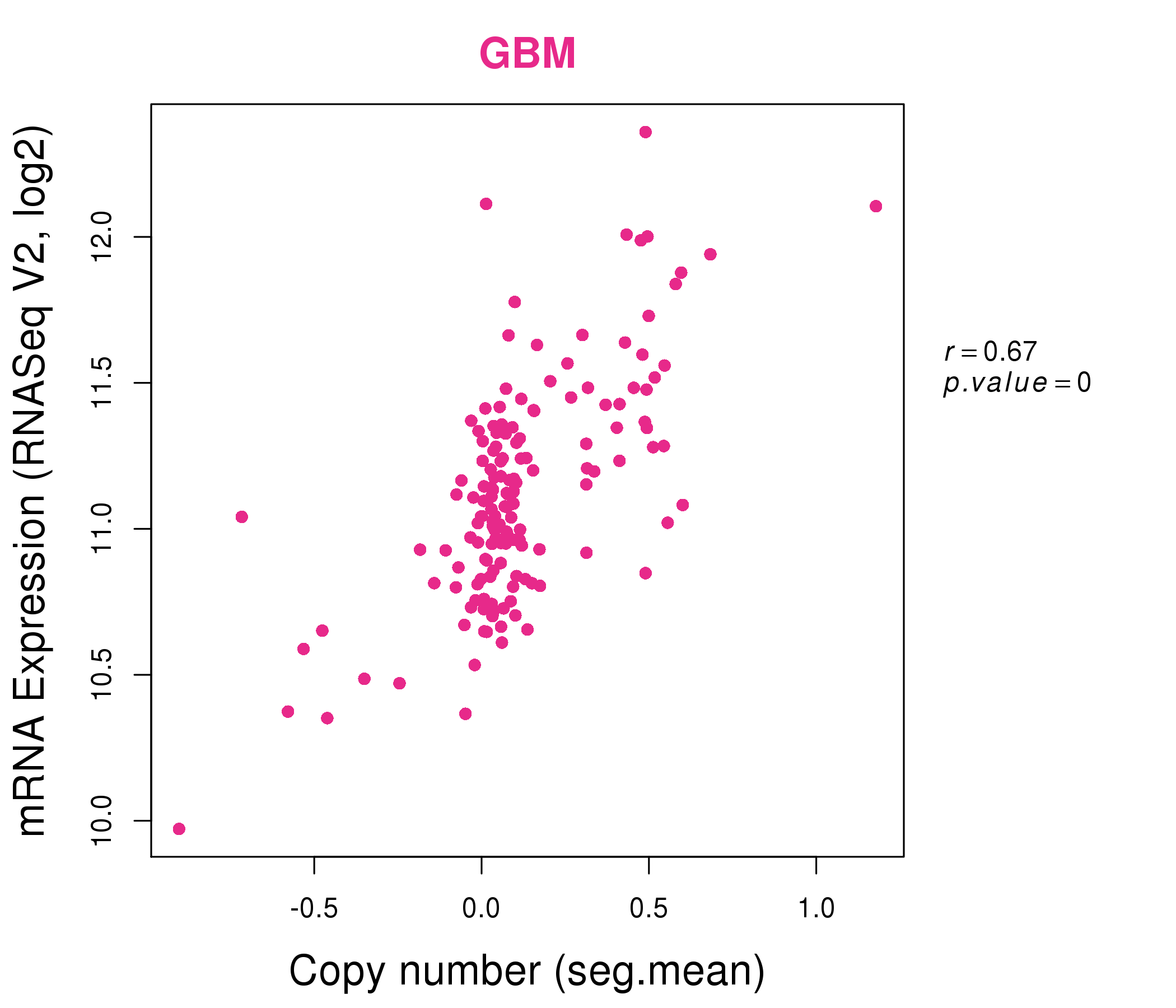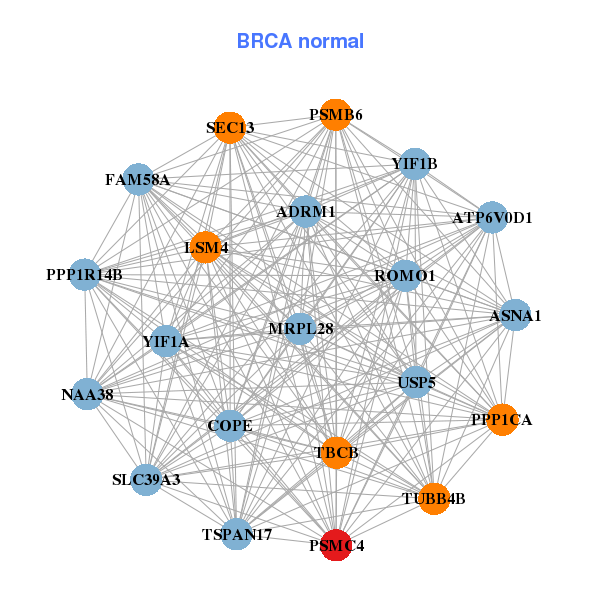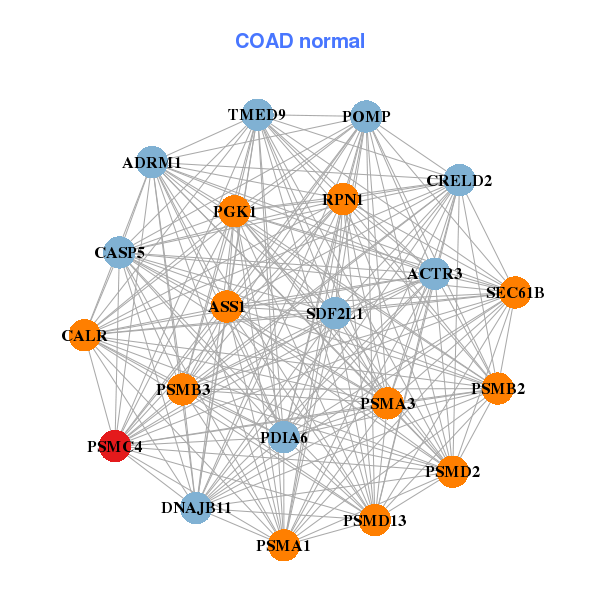|
|||||||||||||||||||||||||||||||||||||||||||||||||||||||||||||||||||||||||||||||||||||||||||||||||||||||||||||||||||||||||||||||||||||||||||||||||||||||||||||||||||||||||||||||||||||||||||||||||||||||||||||||||||||||||||||||||||||||||||||||||||||||||||||||||||||||||||||||||||||||||||||||||||||||||||||||||||||||||||||||||||||||||||||
| |
| Phenotypic Information (metabolism pathway, cancer, disease, phenome) |
| |
| |
| Gene-Gene Network Information: Co-Expression Network, Interacting Genes & KEGG |
| |
|
| Gene Summary for PSMC4 |
| Basic gene info. | Gene symbol | PSMC4 |
| Gene name | proteasome (prosome, macropain) 26S subunit, ATPase, 4 | |
| Synonyms | MIP224|RPT3|S6|TBP-7|TBP7 | |
| Cytomap | UCSC genome browser: 19q13.11-q13.13 | |
| Genomic location | chr19 :40477072-40487353 | |
| Type of gene | protein-coding | |
| RefGenes | NM_006503.3, NM_153001.2, | |
| Ensembl id | ENSG00000013275 | |
| Description | 26S protease regulatory subunit 6B26S proteasome AAA-ATPase subunit RPT3MB67-interacting proteinTat-binding protein 7protease 26S subunit 6 | |
| Modification date | 20141207 | |
| dbXrefs | MIM : 602707 | |
| HGNC : HGNC | ||
| Ensembl : ENSG00000013275 | ||
| HPRD : 04085 | ||
| Vega : OTTHUMG00000182577 | ||
| Protein | UniProt: go to UniProt's Cross Reference DB Table | |
| Expression | CleanEX: HS_PSMC4 | |
| BioGPS: 5704 | ||
| Gene Expression Atlas: ENSG00000013275 | ||
| The Human Protein Atlas: ENSG00000013275 | ||
| Pathway | NCI Pathway Interaction Database: PSMC4 | |
| KEGG: PSMC4 | ||
| REACTOME: PSMC4 | ||
| ConsensusPathDB | ||
| Pathway Commons: PSMC4 | ||
| Metabolism | MetaCyc: PSMC4 | |
| HUMANCyc: PSMC4 | ||
| Regulation | Ensembl's Regulation: ENSG00000013275 | |
| miRBase: chr19 :40,477,072-40,487,353 | ||
| TargetScan: NM_006503 | ||
| cisRED: ENSG00000013275 | ||
| Context | iHOP: PSMC4 | |
| cancer metabolism search in PubMed: PSMC4 | ||
| UCL Cancer Institute: PSMC4 | ||
| Assigned class in ccmGDB | C | |
| Top |
| Phenotypic Information for PSMC4(metabolism pathway, cancer, disease, phenome) |
| Cancer | CGAP: PSMC4 |
| Familial Cancer Database: PSMC4 | |
| * This gene is included in those cancer gene databases. |
|
|
|
|
|
| . | |||||||||||||||||||||||||||||||||||||||||||||||||||||||||||||||||||||||||||||||||||||||||||||||||||||||||||||||||||||||||||||||||||||||||||||||||||||||||||||||||||||||||||||||||||||||||||||||||||||||||||||||||||||||||||||||||||||||||||||||||||||||||||||||||||||||||||||||||||||||||||||||||||||||||||||||||||||||||||||||||||||||
Oncogene 1 | Significant driver gene in | ||||||||||||||||||||||||||||||||||||||||||||||||||||||||||||||||||||||||||||||||||||||||||||||||||||||||||||||||||||||||||||||||||||||||||||||||||||||||||||||||||||||||||||||||||||||||||||||||||||||||||||||||||||||||||||||||||||||||||||||||||||||||||||||||||||||||||||||||||||||||||||||||||||||||||||||||||||||||||||||||||||||||||||
| cf) number; DB name 1 Oncogene; http://nar.oxfordjournals.org/content/35/suppl_1/D721.long, 2 Tumor Suppressor gene; https://bioinfo.uth.edu/TSGene/, 3 Cancer Gene Census; http://www.nature.com/nrc/journal/v4/n3/abs/nrc1299.html, 4 CancerGenes; http://nar.oxfordjournals.org/content/35/suppl_1/D721.long, 5 Network of Cancer Gene; http://ncg.kcl.ac.uk/index.php, 1Therapeutic Vulnerabilities in Cancer; http://cbio.mskcc.org/cancergenomics/statius/ |
| REACTOME_METABOLISM_OF_AMINO_ACIDS_AND_DERIVATIVES REACTOME_METABOLISM_OF_MRNA REACTOME_METABOLISM_OF_RNA | |
| OMIM | |
| Orphanet | |
| Disease | KEGG Disease: PSMC4 |
| MedGen: PSMC4 (Human Medical Genetics with Condition) | |
| ClinVar: PSMC4 | |
| Phenotype | MGI: PSMC4 (International Mouse Phenotyping Consortium) |
| PhenomicDB: PSMC4 | |
| Mutations for PSMC4 |
| * Under tables are showing count per each tissue to give us broad intuition about tissue specific mutation patterns.You can go to the detailed page for each mutation database's web site. |
| There's no structural variation information in COSMIC data for this gene. |
| * From mRNA Sanger sequences, Chitars2.0 arranged chimeric transcripts. This table shows PSMC4 related fusion information. |
| ID | Head Gene | Tail Gene | Accession | Gene_a | qStart_a | qEnd_a | Chromosome_a | tStart_a | tEnd_a | Gene_a | qStart_a | qEnd_a | Chromosome_a | tStart_a | tEnd_a |
| BP432759 | MXD4 | 9 | 87 | 4 | 2259708 | 2263498 | PSMC4 | 87 | 369 | 19 | 40485976 | 40486604 | |
| BQ219974 | ELL3 | 1 | 479 | 15 | 44084544 | 44086239 | PSMC4 | 479 | 557 | 19 | 40480336 | 40480497 | |
| AI143487 | PSMC4 | 10 | 124 | 19 | 40487233 | 40487348 | WNT7B | 121 | 186 | 22 | 46316306 | 46316371 | |
| BU674697 | PSMC4 | 17 | 138 | 19 | 40487233 | 40487353 | PSMC4 | 138 | 339 | 19 | 40486343 | 40487225 | |
| BU608468 | PSMC4 | 17 | 126 | 19 | 40487235 | 40487344 | PSMC4 | 121 | 265 | 19 | 40487098 | 40487242 | |
| CV361424 | PSMC4 | 1 | 134 | 19 | 40485834 | 40486052 | PSMC4 | 131 | 476 | 19 | 40477072 | 40478447 | |
| Top |
| Mutation type/ Tissue ID | brca | cns | cerv | endome | haematopo | kidn | Lintest | liver | lung | ns | ovary | pancre | prost | skin | stoma | thyro | urina | |||
| Total # sample | 1 | |||||||||||||||||||
| GAIN (# sample) | 1 | |||||||||||||||||||
| LOSS (# sample) |
| cf) Tissue ID; Tissue type (1; Breast, 2; Central_nervous_system, 3; Cervix, 4; Endometrium, 5; Haematopoietic_and_lymphoid_tissue, 6; Kidney, 7; Large_intestine, 8; Liver, 9; Lung, 10; NS, 11; Ovary, 12; Pancreas, 13; Prostate, 14; Skin, 15; Stomach, 16; Thyroid, 17; Urinary_tract) |
| Top |
|
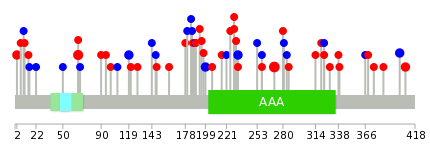 |
| Top |
| Stat. for Non-Synonymous SNVs (# total SNVs=39) | (# total SNVs=15) |
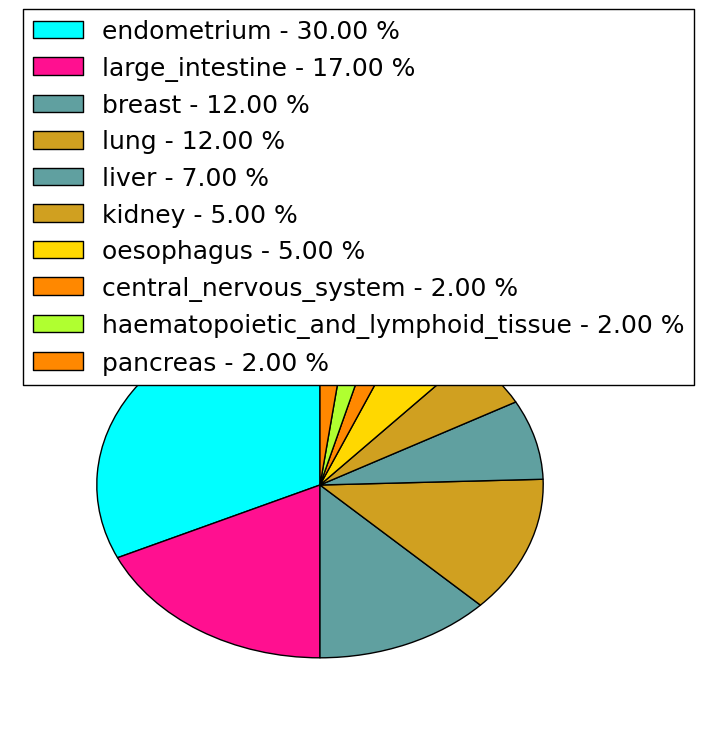 | 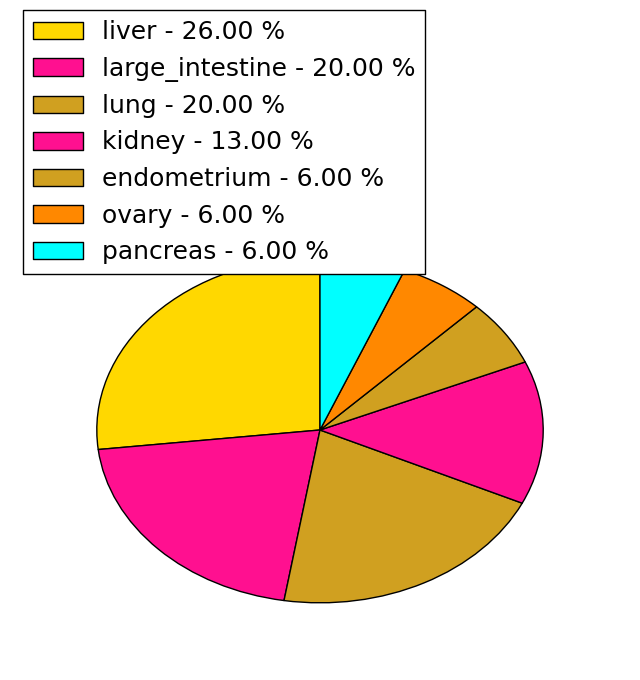 |
(# total SNVs=3) | (# total SNVs=2) |
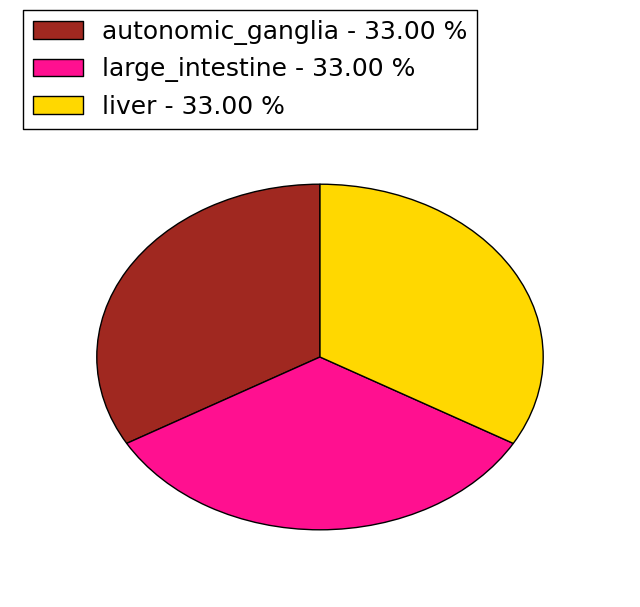 | 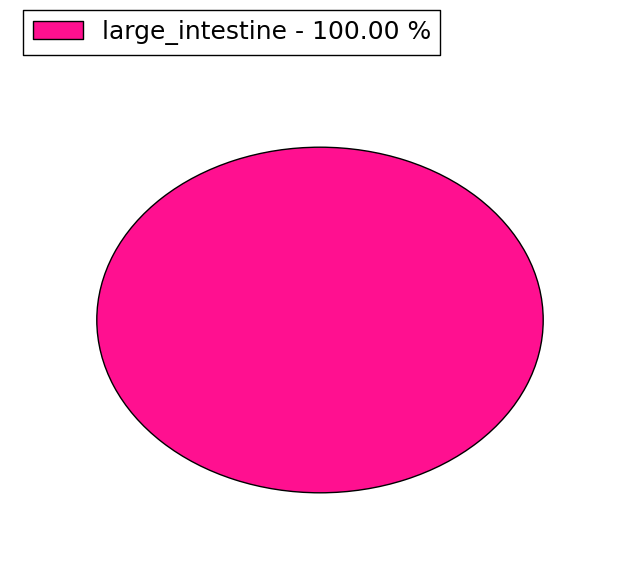 |
| Top |
| * When you move the cursor on each content, you can see more deailed mutation information on the Tooltip. Those are primary_site,primary_histology,mutation(aa),pubmedID. |
| GRCh37 position | Mutation(aa) | Unique sampleID count |
| chr19:40485861-40485861 | p.A271T | 4 |
| chr19:40478338-40478338 | p.K66N | 3 |
| chr19:40477113-40477113 | p.E2K | 2 |
| chr19:40480653-40480654 | p.R200fs*43 | 2 |
| chr19:40480659-40480659 | p.P199P | 2 |
| chr19:40485749-40485749 | p.S233S | 2 |
| chr19:40487161-40487161 | p.A402A | 2 |
| chr19:40487178-40487178 | p.K408T | 2 |
| chr19:40480235-40480235 | p.I119I | 2 |
| chr19:40480651-40480651 | p.D197Y | 1 |
| Top |
|
 |
| Point Mutation/ Tissue ID | 1 | 2 | 3 | 4 | 5 | 6 | 7 | 8 | 9 | 10 | 11 | 12 | 13 | 14 | 15 | 16 | 17 | 18 | 19 | 20 |
| # sample | 1 | 3 | 4 | 1 | 2 | 7 | 2 | 1 | 1 | 5 | 6 | 11 | ||||||||
| # mutation | 1 | 3 | 4 | 1 | 2 | 7 | 2 | 1 | 1 | 4 | 6 | 10 | ||||||||
| nonsynonymous SNV | 3 | 3 | 1 | 4 | 2 | 1 | 2 | 9 | ||||||||||||
| synonymous SNV | 1 | 1 | 2 | 3 | 1 | 1 | 3 | 4 | 1 |
| cf) Tissue ID; Tissue type (1; BLCA[Bladder Urothelial Carcinoma], 2; BRCA[Breast invasive carcinoma], 3; CESC[Cervical squamous cell carcinoma and endocervical adenocarcinoma], 4; COAD[Colon adenocarcinoma], 5; GBM[Glioblastoma multiforme], 6; Glioma Low Grade, 7; HNSC[Head and Neck squamous cell carcinoma], 8; KICH[Kidney Chromophobe], 9; KIRC[Kidney renal clear cell carcinoma], 10; KIRP[Kidney renal papillary cell carcinoma], 11; LAML[Acute Myeloid Leukemia], 12; LUAD[Lung adenocarcinoma], 13; LUSC[Lung squamous cell carcinoma], 14; OV[Ovarian serous cystadenocarcinoma ], 15; PAAD[Pancreatic adenocarcinoma], 16; PRAD[Prostate adenocarcinoma], 17; SKCM[Skin Cutaneous Melanoma], 18:STAD[Stomach adenocarcinoma], 19:THCA[Thyroid carcinoma], 20:UCEC[Uterine Corpus Endometrial Carcinoma]) |
| Top |
| * We represented just top 10 SNVs. When you move the cursor on each content, you can see more deailed mutation information on the Tooltip. Those are primary_site, primary_histology, mutation(aa), pubmedID. |
| Genomic Position | Mutation(aa) | Unique sampleID count |
| chr19:40478338 | p.K66N | 3 |
| chr19:40485861 | p.I119I,PSMC4 | 2 |
| chr19:40480235 | p.A271T,PSMC4 | 2 |
| chr19:40477127 | p.A281A,PSMC4 | 1 |
| chr19:40485987 | p.L185L,PSMC4 | 1 |
| chr19:40480305 | p.E284E,PSMC4 | 1 |
| chr19:40480725 | p.I6M,PSMC4 | 1 |
| chr19:40478061 | p.T186M,PSMC4 | 1 |
| chr19:40486241 | p.R323W,PSMC4 | 1 |
| chr19:40480456 | p.I15I,PSMC4 | 1 |
| * Copy number data were extracted from TCGA using R package TCGA-Assembler. The URLs of all public data files on TCGA DCC data server were gathered on Jan-05-2015. Function ProcessCNAData in TCGA-Assembler package was used to obtain gene-level copy number value which is calculated as the average copy number of the genomic region of a gene. |
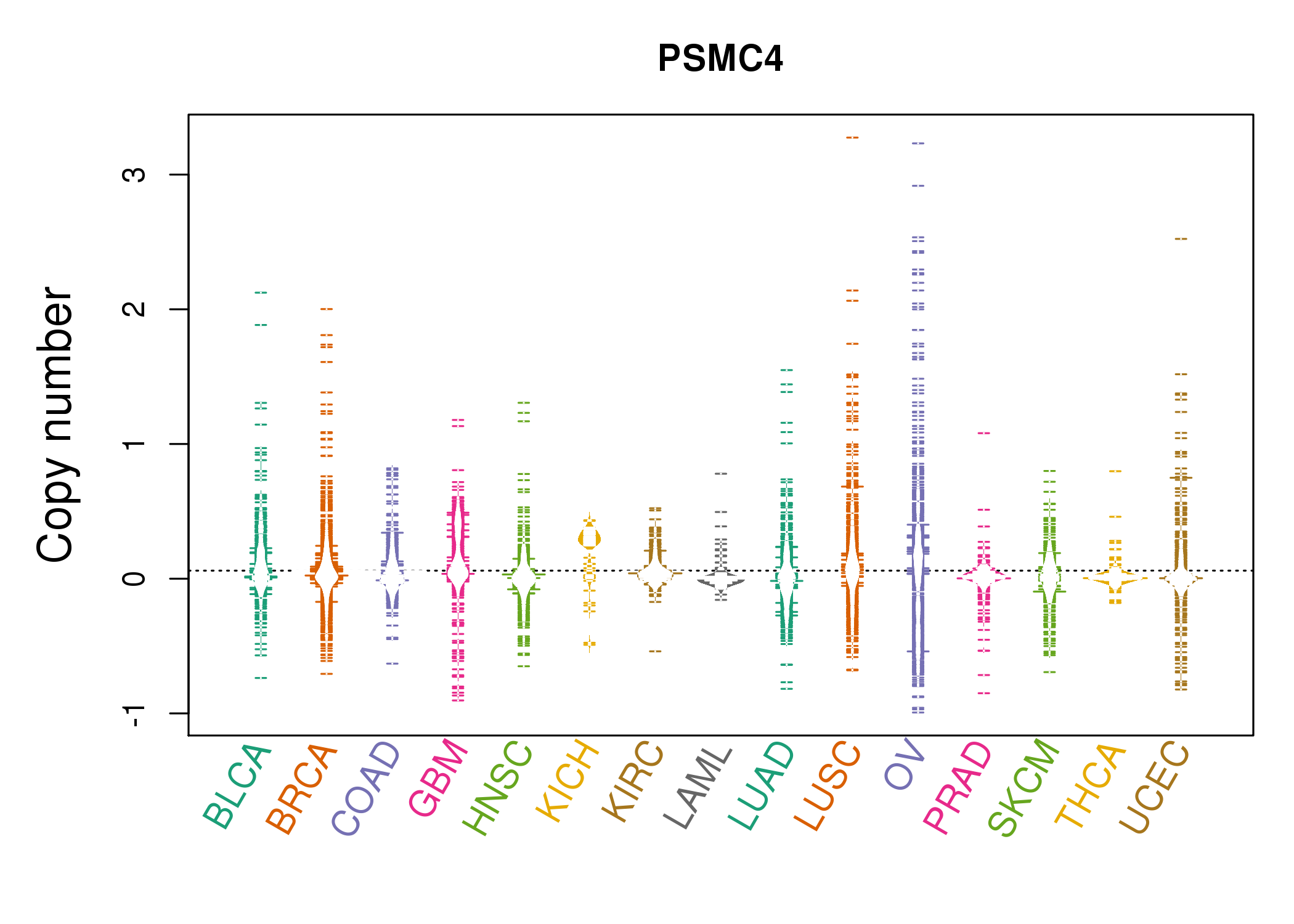 |
| cf) Tissue ID[Tissue type]: BLCA[Bladder Urothelial Carcinoma], BRCA[Breast invasive carcinoma], CESC[Cervical squamous cell carcinoma and endocervical adenocarcinoma], COAD[Colon adenocarcinoma], GBM[Glioblastoma multiforme], Glioma Low Grade, HNSC[Head and Neck squamous cell carcinoma], KICH[Kidney Chromophobe], KIRC[Kidney renal clear cell carcinoma], KIRP[Kidney renal papillary cell carcinoma], LAML[Acute Myeloid Leukemia], LUAD[Lung adenocarcinoma], LUSC[Lung squamous cell carcinoma], OV[Ovarian serous cystadenocarcinoma ], PAAD[Pancreatic adenocarcinoma], PRAD[Prostate adenocarcinoma], SKCM[Skin Cutaneous Melanoma], STAD[Stomach adenocarcinoma], THCA[Thyroid carcinoma], UCEC[Uterine Corpus Endometrial Carcinoma] |
| Top |
| Gene Expression for PSMC4 |
| * CCLE gene expression data were extracted from CCLE_Expression_Entrez_2012-10-18.res: Gene-centric RMA-normalized mRNA expression data. |
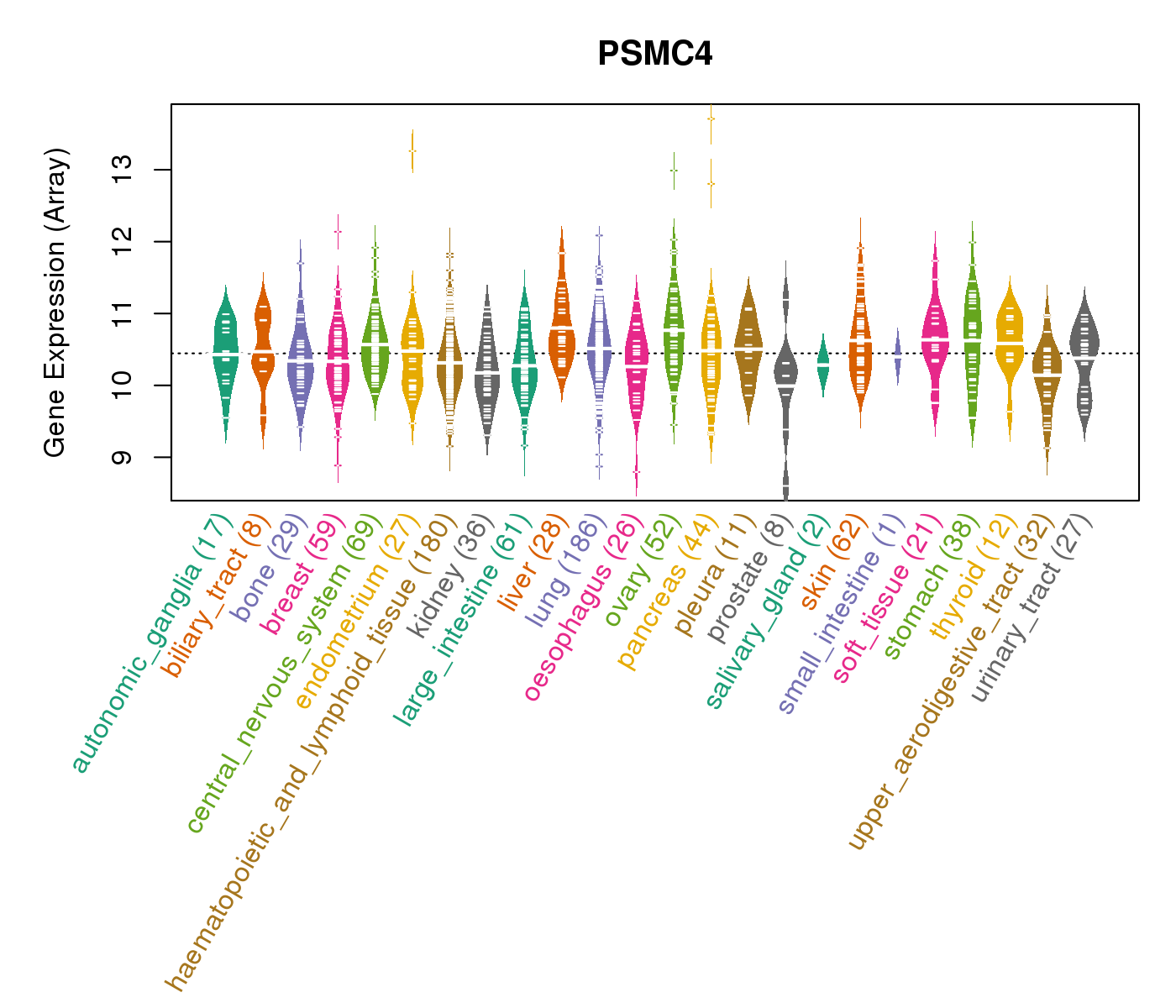 |
| * Normalized gene expression data of RNASeqV2 was extracted from TCGA using R package TCGA-Assembler. The URLs of all public data files on TCGA DCC data server were gathered at Jan-05-2015. Only eight cancer types have enough normal control samples for differential expression analysis. (t test, adjusted p<0.05 (using Benjamini-Hochberg FDR)) |
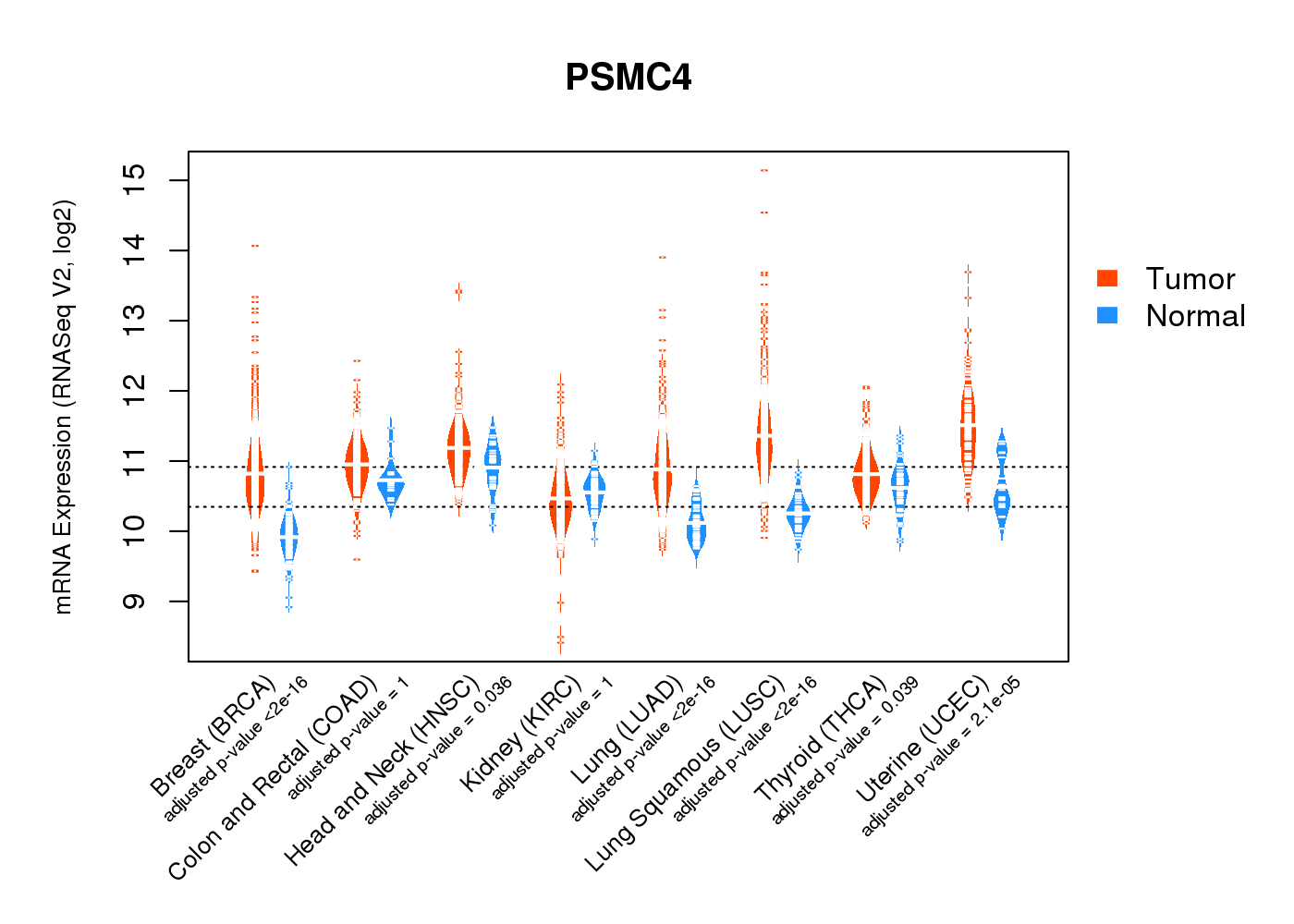 |
| Top |
| * This plots show the correlation between CNV and gene expression. |
: Open all plots for all cancer types
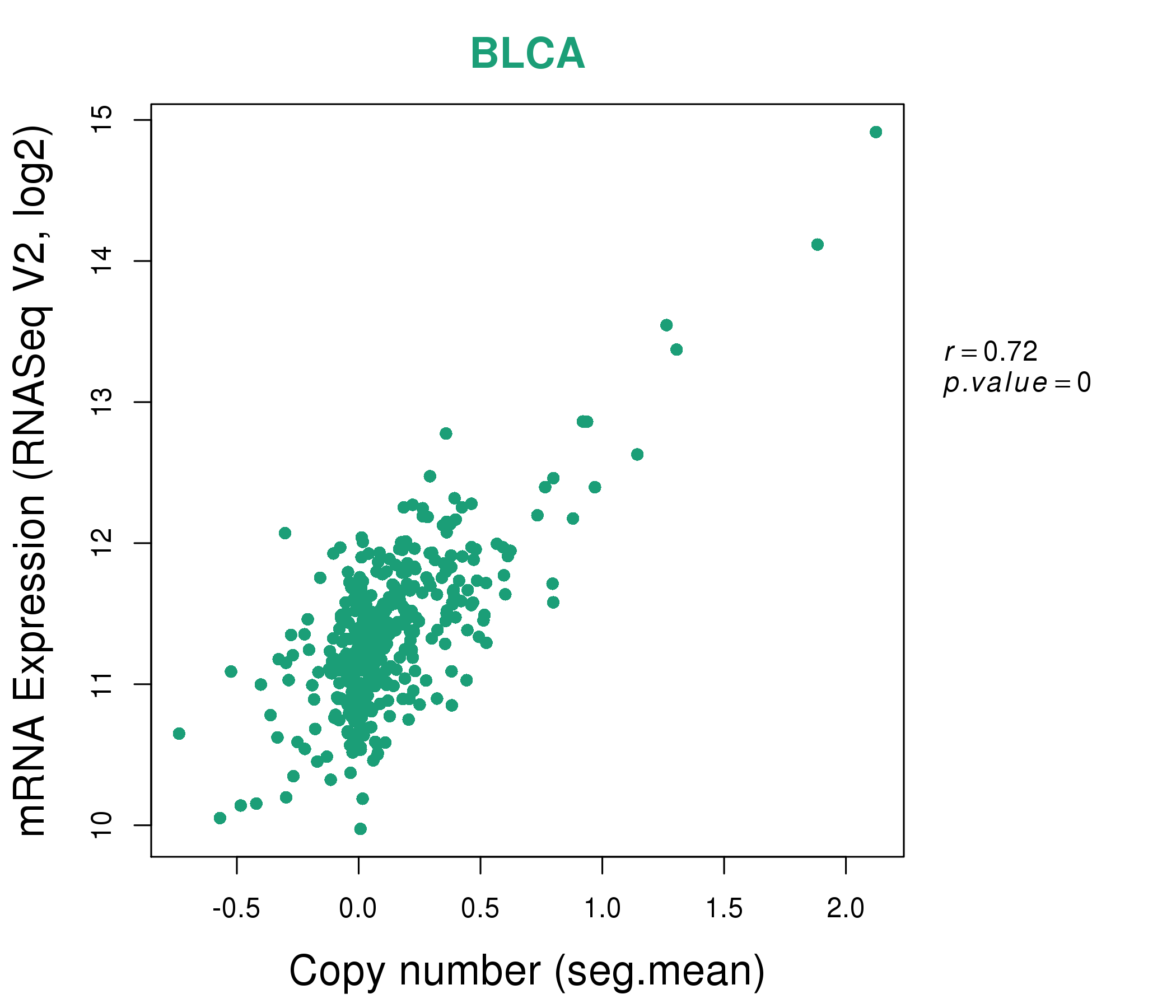 |
|
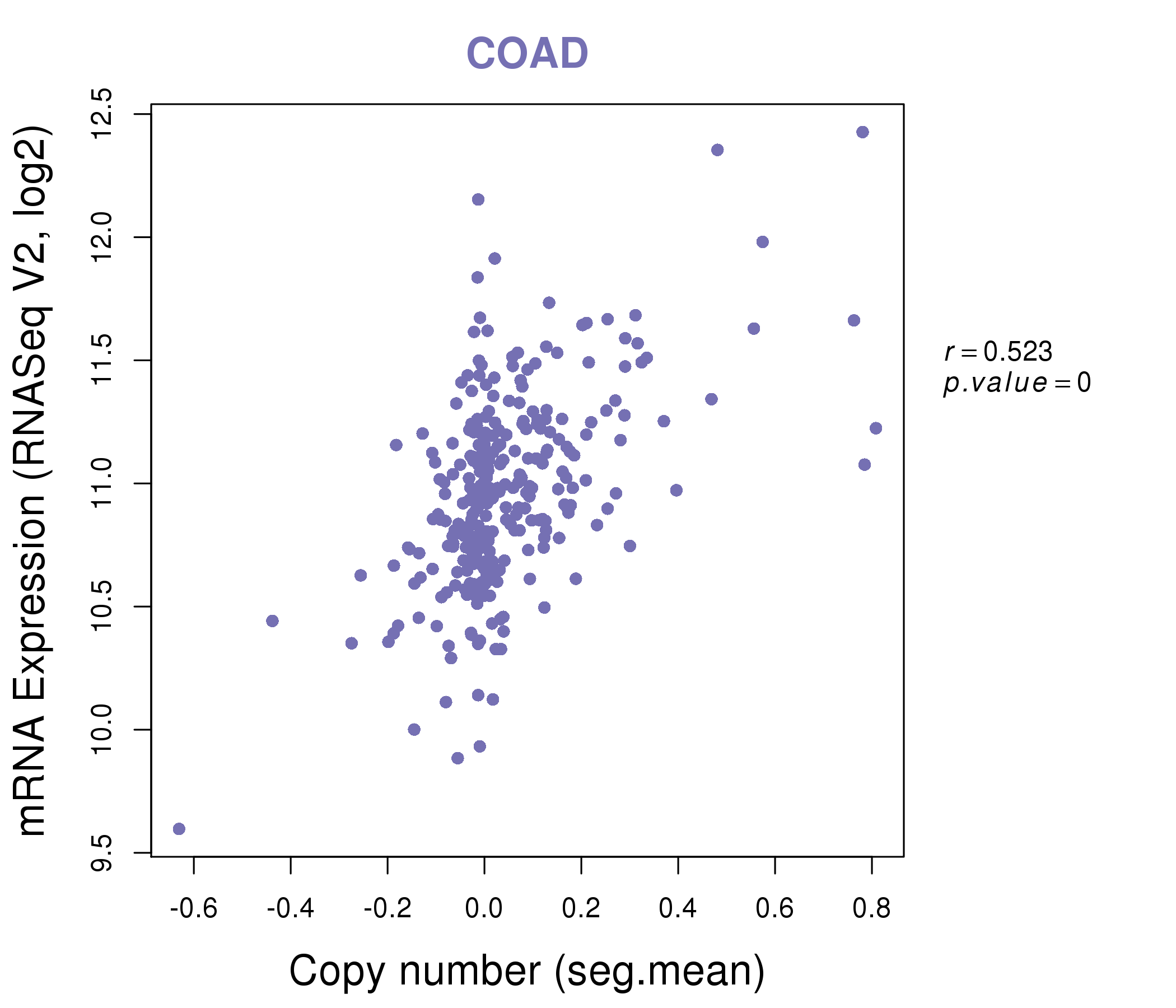 |
|
| Top |
| Gene-Gene Network Information |
| * Co-Expression network figures were drawn using R package igraph. Only the top 20 genes with the highest correlations were shown. Red circle: input gene, orange circle: cell metabolism gene, sky circle: other gene |
: Open all plots for all cancer types
 |
| ||||
| AKT2,C19orf47,COX6B1,EID2,EIF3K,FBL,LRFN1, MAP3K10,MRPS12,NFKBIB,PAF1,PSMC4,PSMD8,RPS16, SARS2,SHKBP1,SIRT2,SPINT2,SUPT5H,TIMM50,YIF1B | ADRM1,ASNA1,ATP6V0D1,COPE,FAM58A,LSM4,NAA38, MRPL28,PPP1CA,PPP1R14B,PSMB6,PSMC4,ROMO1,SEC13, SLC39A3,TBCB,TSPAN17,TUBB4B,USP5,YIF1A,YIF1B | ||||
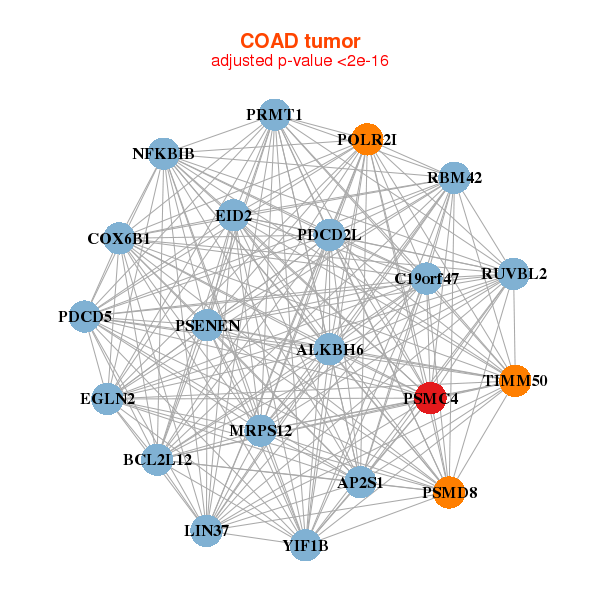 |
| ||||
| ALKBH6,AP2S1,BCL2L12,C19orf47,COX6B1,EGLN2,EID2, LIN37,MRPS12,NFKBIB,PDCD2L,PDCD5,POLR2I,PRMT1, PSENEN,PSMC4,PSMD8,RBM42,RUVBL2,TIMM50,YIF1B | ACTR3,ADRM1,ASS1,CALR,CASP5,CRELD2,DNAJB11, PDIA6,PGK1,POMP,PSMA1,PSMA3,PSMB2,PSMB3, PSMC4,PSMD13,PSMD2,RPN1,SDF2L1,SEC61B,TMED9 |
| * Co-Expression network figures were drawn using R package igraph. Only the top 20 genes with the highest correlations were shown. Red circle: input gene, orange circle: cell metabolism gene, sky circle: other gene |
: Open all plots for all cancer types
| Top |
: Open all interacting genes' information including KEGG pathway for all interacting genes from DAVID
| Top |
| Pharmacological Information for PSMC4 |
| DB Category | DB Name | DB's ID and Url link |
| * Gene Centered Interaction Network. |
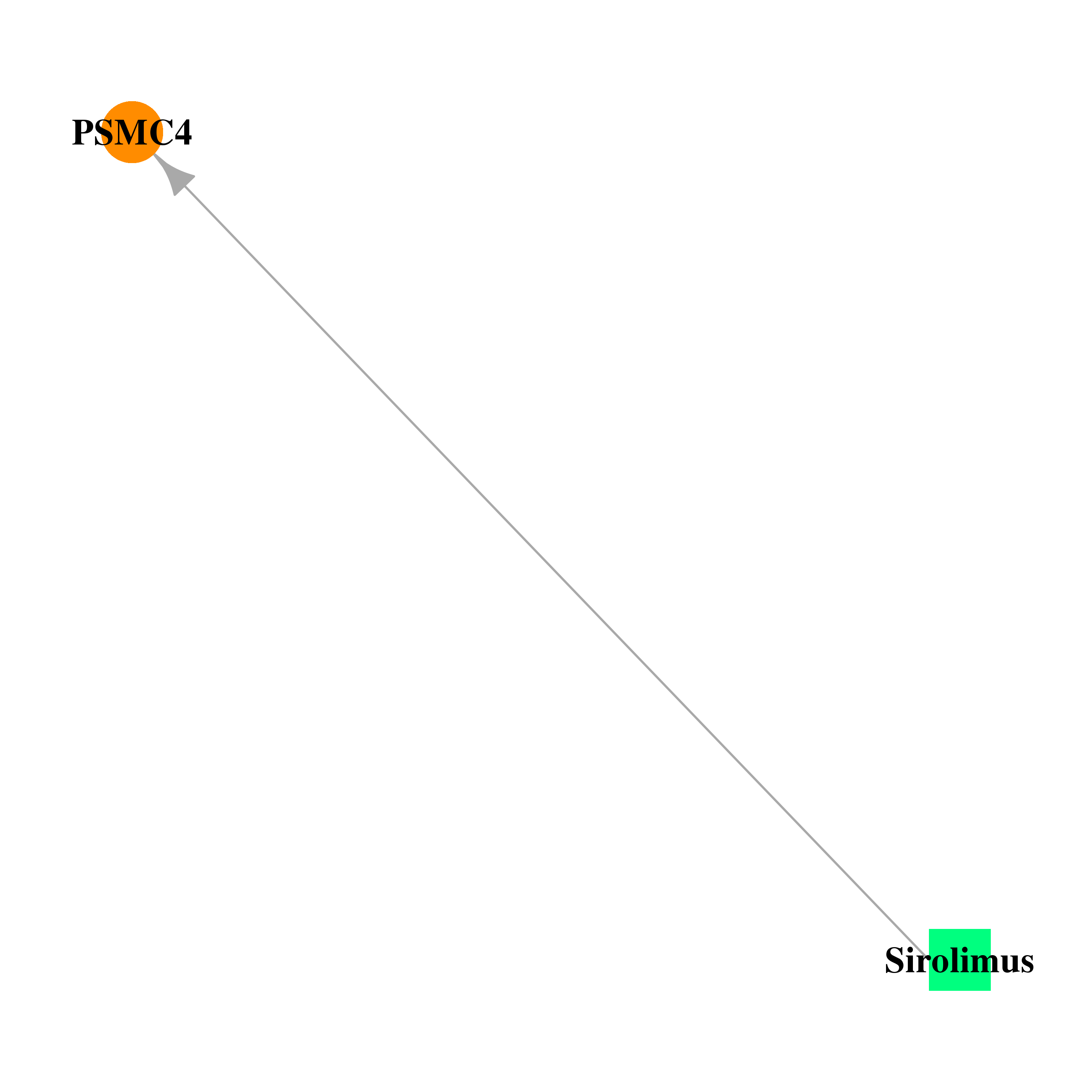 |
| * Drug Centered Interaction Network. |
| DrugBank ID | Target Name | Drug Groups | Generic Name | Drug Centered Network | Drug Structure |
| DB00877 | proteasome (prosome, macropain) 26S subunit, ATPase, 4 | approved; investigational | Sirolimus | 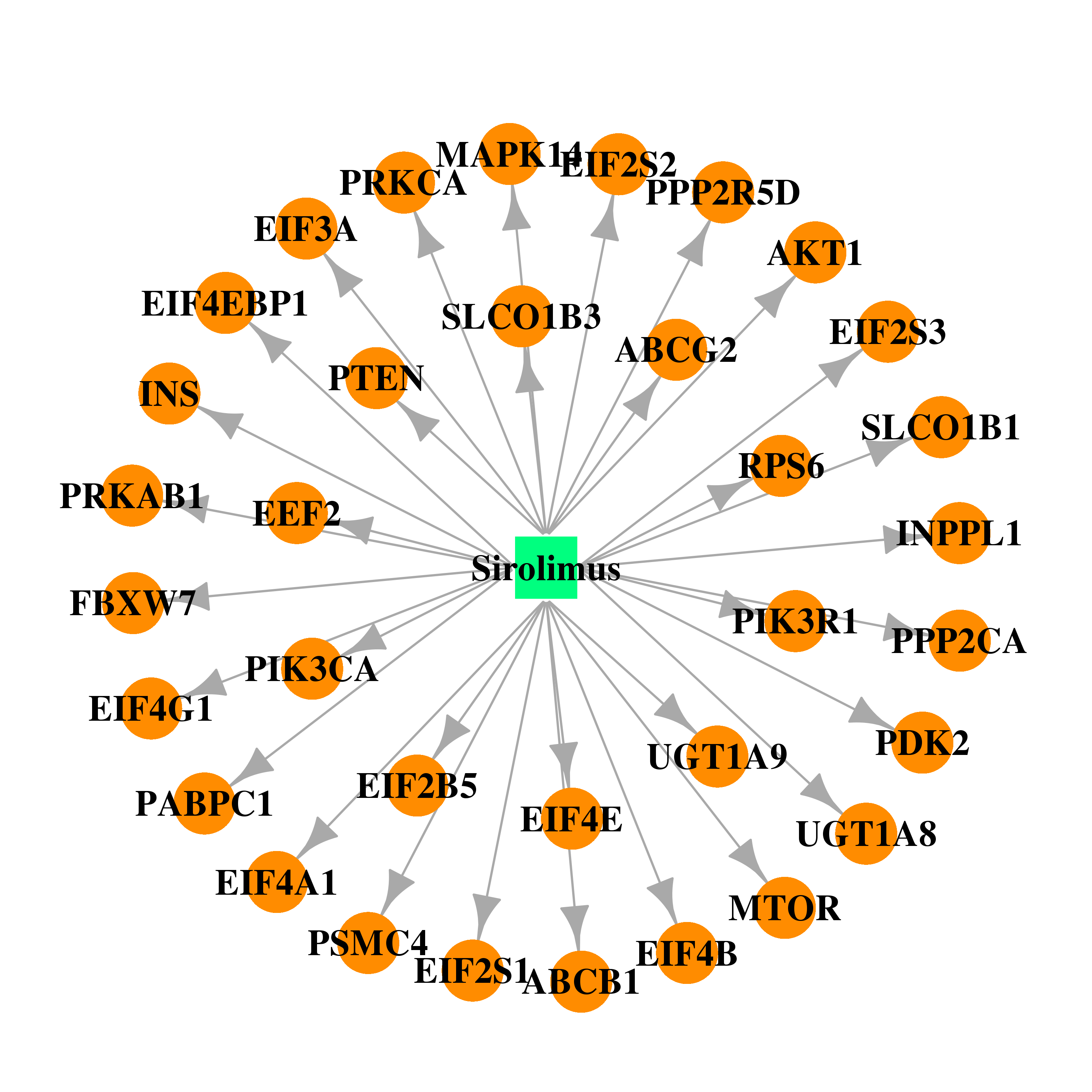 | 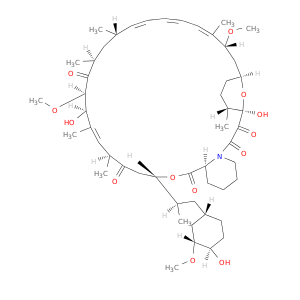 |
| Top |
| Cross referenced IDs for PSMC4 |
| * We obtained these cross-references from Uniprot database. It covers 150 different DBs, 18 categories. http://www.uniprot.org/help/cross_references_section |
: Open all cross reference information
|
Copyright © 2016-Present - The Univsersity of Texas Health Science Center at Houston @ |






